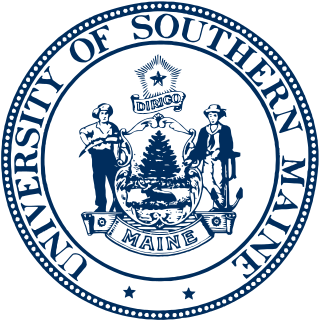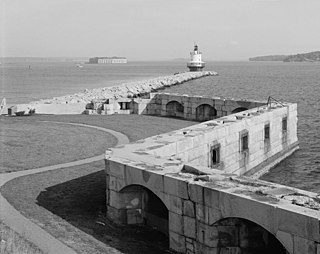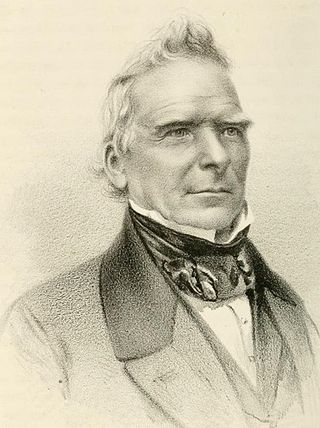
Maine is the easternmost state in the New England region of the Northeastern United States. It borders New Hampshire to the west, the Gulf of Maine to the southeast, and the Canadian provinces of New Brunswick and Quebec to the northeast and northwest, respectively. Maine is the largest state in New England by total area. Of the 50 U.S. states, it is the 12th-smallest by area, the 9th-least populous, the 13th-least densely populated, and the most rural. Maine's capital is Augusta, and its most populous city is Portland, with a total population of 68,408, as of the 2020 census.

South Portland is a city in Cumberland County, Maine, United States, and is the fourth-most populous city in the state, incorporated in 1898. At the 2020 census, the city population was 26,498. Known for its working waterfront, South Portland is situated on Portland Harbor and overlooks the skyline of Portland and the islands of Casco Bay. Due to South Portland's close proximity to air, marine, rail, and highway transportation options, the city has become a center for retail and industry in the region. The Maine Mall, the largest shopping mall in the state, is located in South Portland.

Brunswick is a town in Cumberland County, Maine, United States. Brunswick is included in the Lewiston-Auburn, Maine metropolitan New England city and town area. The population was 21,756 at the 2020 United States Census. Part of the Portland-South Portland-Biddeford metropolitan area, Brunswick is home to Bowdoin College, the Bowdoin International Music Festival, the Bowdoin College Museum of Art, the Peary–MacMillan Arctic Museum, and the Maine State Music Theatre. It was formerly home to the U.S. Naval Air Station Brunswick, which was permanently closed on May 31, 2011, and has since been partially released to redevelopment as "Brunswick Landing".

The State University of New York at Delhi is a public college in Delhi, New York. It is part of the State University of New York (SUNY) system. Over 3,000 students attend the institution.

The University of Southern Maine (USM) is a public university with campuses in Portland, Gorham and Lewiston in the U.S. state of Maine. It is the southernmost of the University of Maine System. It was founded as two separate state universities, Gorham Normal School and Portland University. The two universities, later known as Gorham State College and the University of Maine at Portland, were combined in 1970 to help streamline the public university system in Maine and eventually expanded by adding the Lewiston campus in 1988.

Spring Point Ledge Light is a sparkplug lighthouse in South Portland, Maine, that marks a dangerous obstruction on the west side of the main shipping channel into Portland Harbor. It is now adjacent to the campus of Southern Maine Community College.

The University of Arkansas–Fort Smith (UAFS) is a 4-year, public university in Fort Smith, Arkansas, United States. Part of the University of Arkansas System, UAFS is the sixth-largest university in Arkansas with a fall 2020 enrollment of approximately 6,500 students.

The Battle of Portland Harbor was an incident during the American Civil War, in June 1863, in the waters off Portland, Maine. Two civilian ships engaged two vessels under Confederate States Navy employment.

Fort Preble was a military fort in South Portland, Maine, United States, built in 1808 and progressively added to through 1906. The fort was active during all major wars from the War of 1812 through World War II. The fort was deactivated in 1950. It is now on the campus of Southern Maine Community College.

Alexander Wadsworth Longfellow Jr. was an American architect and nephew of poet Henry Wadsworth Longfellow.
Central Maine Community College is a public community college in Auburn, Maine. It is part of the Maine Community College System.

South Mountain Community College is a public community college in Phoenix, Arizona. It is one of the ten colleges in the Maricopa County Community College District.

The Maine Community College System (MCCS) is Maine's comprehensive two-year college system, offering nearly 300 technical, career, and transfer programs; customized training; and lifelong learning. Maine's seven community colleges are located in Auburn, Bangor, Fairfield/Hinckley, Presque Isle, South Portland/Brunswick, Calais, and Wells. MCCS awarded 2,766 credentials in 2014-15, a 62% increase over the 1,712 credentials awarded in 2003-04, the year Maine's technical colleges became community colleges. In fall 2015, 17,464 students enrolled in credit courses.

William Pitt Preble was an American lawyer, judge, diplomat and businessman. He was one of the first Justices of the Maine Supreme Court and U.S. Minister to the Netherlands.

Thelma Cowey Swain was an American philanthropist. She contributed significant funds to non-profit organizations in Maine and also established scholarships at Middlebury College, Tufts University, and at each of the seven colleges of the Maine Community College System. In 2010, her estate bequeathed $1 million to The Foundation for Maine's Community Colleges. She was posthumously inducted into the Maine Women's Hall of Fame in 2010.

The Harbor Defenses of Portland was a United States Army Coast Artillery Corps harbor defense command. It coordinated the coast defenses of Portland, Maine, the mouth of the Kennebec River, and surrounding areas from 1895 to 1950, beginning with the Endicott program. These included both coast artillery forts and underwater minefields. The command originated circa 1895 as the Portland Artillery District, was renamed Coast Defenses of Portland in 1913, and again renamed Harbor Defenses of Portland in 1925.
The COVID-19 pandemic was publicly reported to have reached the U.S. state of Maine on March 12, 2020. As of February 2, 2021, the Maine Department of Health and Human Services reported 131,530 confirmed cases and 46,971 probable cases in the state, with 1,777 deaths attributed to the virus.

Old Settlers Cemetery, also known as Thrasher Cemetery, is a historic cemetery in South Portland, Maine, United States. South Portland's oldest landmark, dating to 1658, it stands today in the grounds of Southern Maine Community College, adjacent to Willard Beach. There are eighteen marked graves in the cemetery, but it is believed there are several more unmarked burials. The oldest visible burial is that of Ann Simonton, a Scot from today's Argyll and Bute, who died in April 1744. Seven headstones are of members of the Thrasher family, hence the cemetery's alternative name.

Public transportation in Maine is available for all four main modes of transport—air, bus, ferry and rail—assisting residents and visitors without their own vehicle to travel around much of Maine's 31,000 square miles (80,000 km2).




















